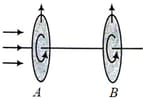Uses of Plane Polarised Light and Polaroids
Uses of Plane Polarised Light and Polaroids: Overview
This topic covers concepts, such as, Law of Malus, Polaroids, Pass-Axis of a Polaroid, Passage of Light Through Two Polaroids, Role of Polariser, Role of Analyser, Application of Polaroids, Construction of Polaroid & Working of Polaroid etc.
Important Questions on Uses of Plane Polarised Light and Polaroids
The angle at which the intensity of transmitted light becomes maximum when a polarising sheet is rotated between two crossed polaroids is
[ is the angle between transmission axes of first and middle polaroid]
Three circularly shaped linear polarisers are placed coaxially. The transmission axis of the first polariser is at , the second one is at and the third at to the vertical all in the clockwise sense. Each polariser additionally absorbs of the light. If a vertically polarised beam of light of intensity is incident on this assembly of polarisers, then the final intensity of the transmitted light will be close to:
Suppose transmitted light waves coming from the analyser. SO, when will the coming waves changes?
In what direction we can move the analyser in an experiment?
In the experiment of the polarisation, where do we have to put analyser?
Two polaroids are oriented with their principal planes making an angle of . The percentage of incident unpolarized light which does not pass through the system is
An unpolarized light beam is incident on the polarizer of a polarization experiment and the intensity of light beam emerging from the analyzer is measured as 100 Lumens. Now, if the analyzer is rotated around the horizontal axis (direction of light) by in clockwise direction, the intensity of emerging light will be Lumens.
Two polaroids are kept crossed to each other. If one of them is rotated an angle , the percentage of incident light now transmitted through the system is
Two polaroids are crossed to each other. When one of them is rotated through , then what percentage of the incident unpolarized light will be transmitted by the polaroids?
Plane polarized light is passed through a polaroid. On viewing through the polaroid, we find that when the polaroid is given one complete rotation about the direction of the light, one of the following is observed,
A Polaroid is placed at to an incoming light of intensity . Now, the intensity of light passing through Polaroid after polarization would be
A polarized light is incident on a polaroid such that its transmission axis makes an angle of with that of the plane of the polarized light. What is the ratio of intensities of the emergent light to the incident light?
Which of the following are true about polaroids?
In case one, a plane polarized light is incident on a polarizer such that it makes an angle of with the transmission plane of the polarizer. In case two, the angle is changed to . Find the ratio of intensities of the transmitted light in case one and two.
The direction in which the oscillating electric vectors are passed in a Polaroid is:
When an unpolarised light falls on a polaroid:
Two polaroids are placed in the path of unpolarized beam of intensity such that the intensity of light emitted from the second polaroid is . If a third polaroid whose polarization axis makes an angle with the polarization axis of first polaroid is placed between these polaroids such that the intensity of light emerging from the last polaroid is , then angle is,
An unpolarized light of intensity passes through three polarizers, such that the transmission axis of last polarizer is perpendicular to that of first. If the intensity of emergent light is and the angle between the transmission axis of first two polarizers is then
Light from sodium lamp is made to pass through two polaroids placed one after the other in the path of light. Taking the intensity of the incident light as , the intensity of the outcoming light can be varied in the range
Consider two polaroids and as shown. Unpolarised light is incident on polaroid . Now, both the polaroids are rotated simultaneously by in the same sense of rotation such that at every instant, their pass (transmission) axes always remain parallel to each other. During the rotation, intensity of transmitted light through polaroid

